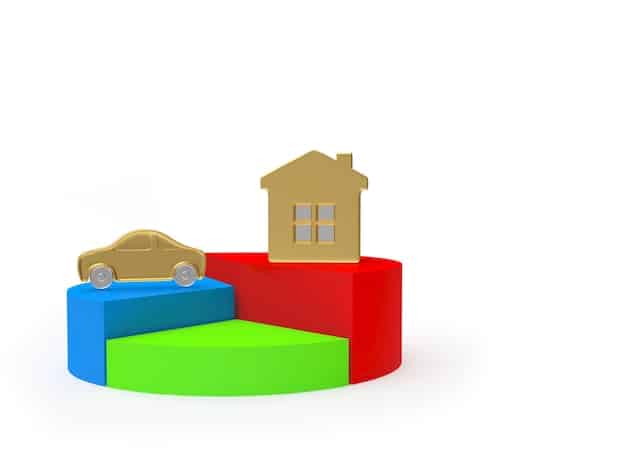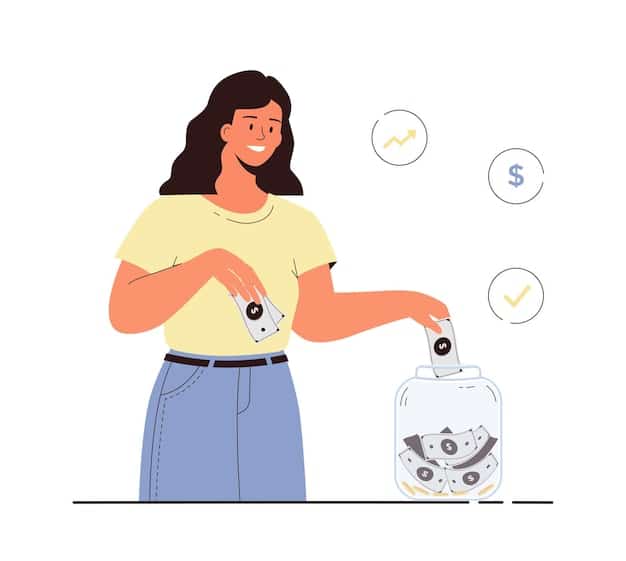Emergency Fund Guide: How Much to Save & Quick Saving Tips

Emergency fund essentials involve determining the right amount to save, typically 3-6 months’ worth of living expenses, and implementing strategies like automating savings, cutting unnecessary expenses, and exploring additional income streams to achieve this financial safety net quickly.
Are you ready to build a financial safety net that can protect you from unexpected events. This guide explores emergency fund essentials, helping you determine how much you really need and providing practical tips to save it quickly.
Understanding the Importance of an Emergency Fund
An emergency fund isn’t just a nice-to-have; it’s a crucial component of financial stability. It acts as a buffer between you and financial disaster, providing a safety net when life throws unexpected curveballs.
Without an emergency fund, you might find yourself relying on credit cards, loans, or even tapping into retirement savings to cover unexpected expenses. This can lead to debt accumulation, high interest payments, and long-term financial setbacks.
Protecting Against the Unexpected
Life is full of surprises, and not all of them are pleasant. Job loss, medical emergencies, car repairs, and unexpected home repairs can all derail your financial plans. An emergency fund provides the resources to handle these situations without going into debt.
Avoiding Debt Accumulation
When faced with an unexpected expense, many people turn to credit cards or loans. These options often come with high interest rates, making it difficult to repay the debt. An emergency fund allows you to avoid this cycle of debt, providing cash when you need it most.
- Job Loss: Provides a financial cushion while you search for new employment.
- Medical Bills: Covers unexpected healthcare costs, such as deductibles or co-pays.
- Home Repairs: Addresses urgent repairs, such as a leaky roof or broken water heater.
- Car Repairs: Handles necessary vehicle maintenance or repairs to keep you on the road.
Investing in an emergency fund is investing in your peace of mind. Knowing you have a financial safety net can reduce stress and anxiety, allowing you to focus on other aspects of your life. It provides a sense of security and control over your finances.
Determining How Much You Really Need
One of the most common questions about emergency funds is, “How much should I save?” The answer isn’t one-size-fits-all, as it depends on your individual circumstances and risk tolerance.
However, a general guideline is to aim for 3-6 months’ worth of living expenses. This will provide a sufficient buffer to cover essential costs during an unexpected financial setback. But how do you calculate that amount?
Calculating Your Monthly Expenses
The first step in determining how much you need in your emergency fund is to calculate your average monthly expenses. This includes everything from rent or mortgage payments to groceries, utilities, transportation, and healthcare costs.
Factors to Consider
Several factors can influence the amount you need in your emergency fund. These include your job security, income stability, health insurance coverage, and the number of dependents you support.
- Job Security: If you work in a stable industry with high demand, you might be comfortable with a smaller emergency fund.
- Income Stability: If you have a consistent income stream, you might need less saved than someone with variable income.
- Health Insurance: Comprehensive health insurance can reduce the need for a large emergency fund to cover medical expenses.
- Dependents: If you have children or other dependents, you’ll likely need a larger emergency fund to cover their needs.

Ultimately, the amount you need in your emergency fund is a personal decision. Consider your individual circumstances and risk tolerance to determine the right amount for you. It’s always better to err on the side of caution and save more than you think you might need.
Creating a Budget to Prioritize Savings
Creating a budget is a fundamental step in saving for an emergency fund. A budget helps you track your income and expenses, identify areas where you can cut back, and allocate funds towards your savings goals.
Without a budget, it’s easy to overspend and lose track of where your money is going. By creating a budget, you gain control over your finances and make informed decisions about how to allocate your resources.
Tracking Your Income and Expenses
The first step in creating a budget is to track your income and expenses. This can be done using a spreadsheet, budgeting app, or even a simple notebook and pen. The key is to be consistent and accurate.
Identifying Areas to Cut Back
Once you’ve tracked your income and expenses for a month or two, you can identify areas where you can cut back. This might include reducing dining out, canceling subscriptions, or finding cheaper alternatives for your current expenses.
- Dining Out: Prepare meals at home instead of eating at restaurants.
- Subscriptions: Cancel any subscriptions you don’t use regularly.
- Entertainment: Find free or low-cost entertainment options, such as hiking or visiting local parks.
Creating a budget isn’t about depriving yourself; it’s about making conscious decisions about how you spend your money. By prioritizing savings, you can build a solid financial foundation and achieve your goals, including building an emergency fund.
Strategies for Saving Quickly
Saving for an emergency fund can seem daunting, especially if you’re starting from scratch. However, there are several strategies you can use to accelerate your savings and reach your goal faster.
These strategies involve making small changes to your spending habits, automating your savings, and finding ways to increase your income. By implementing these tips, you can build your emergency fund more quickly and efficiently.
Automating Your Savings
One of the most effective ways to save is to automate your savings. This involves setting up automatic transfers from your checking account to your savings account each month. This way, you’re saving money without even thinking about it.
Cutting Unnecessary Expenses
Another strategy for saving quickly is to cut unnecessary expenses. This might include reducing your grocery bill, canceling unused subscriptions, or finding cheaper alternatives for your current expenses. Every little bit adds up.

- Grocery Shopping: Plan your meals, make a shopping list, and avoid impulse purchases.
- Transportation: Consider biking, walking, or public transportation instead of driving.
- Utilities: Conserve energy by turning off lights, unplugging electronics, and adjusting your thermostat.
Saving for an emergency fund doesn’t have to be a chore. By implementing these strategies and making small changes to your spending habits, you can build your savings quickly and efficiently. The key is to be consistent and stay focused on your goal.
Where to Keep Your Emergency Fund
Choosing the right place to keep your emergency fund is crucial. You want an account that’s easily accessible when you need it, while also earning some interest to help your savings grow.
While the primary goal is accessibility, you also want to ensure your funds are safe and secure. Several options are available, each with its own advantages and disadvantages.
High-Yield Savings Accounts
High-yield savings accounts offer a higher interest rate than traditional savings accounts, allowing your money to grow faster. They are typically offered by online banks and can be easily accessed when needed.
Money Market Accounts
Money market accounts are similar to savings accounts but often come with check-writing privileges and higher interest rates. They are a good option if you need to access your funds frequently.
- Accessibility: Ensure the account allows for easy withdrawals and transfers.
- FDIC Insurance: Choose an account insured by the Federal Deposit Insurance Corporation (FDIC) for added security.
- Interest Rates: Compare interest rates among different accounts to maximize your earnings.
The right choice depends on your individual needs and preferences. Consider the accessibility, security, and interest rates offered by each option to determine the best place to keep your emergency fund.
Maintaining and Replenishing Your Fund
Building an emergency fund is just the first step. It’s equally important to maintain and replenish your fund after you’ve used it. This ensures you always have a financial safety net in place.
Life is unpredictable, and you never know when you might need to tap into your emergency fund again. By maintaining and replenishing your fund, you’re protecting yourself from future financial setbacks.
Regularly Reviewing Your Expenses
Make it a habit to regularly review your expenses and adjust your budget as needed. This ensures you’re always on track with your savings goals and that your emergency fund is adequately funded.
Replenishing After Use
Whenever you use your emergency fund, make it a priority to replenish it as soon as possible. This might involve cutting back on expenses, increasing your income, or temporarily redirecting funds from other savings goals.
- Set a Goal: Determine how much you need to replenish and set a timeline for achieving it.
- Adjust Your Budget: Identify areas where you can cut back on expenses to free up funds for replenishment.
- Automate Replenishment: Set up automatic transfers from your checking account to your emergency fund until it’s fully replenished.
Maintaining and replenishing your emergency fund is an ongoing process. By staying vigilant and making it a priority, you can ensure you always have a financial safety net in place, providing peace of mind and security.
| Key Point | Brief Description |
|---|---|
| 💰 Savings Goal | Aim for 3-6 months’ worth of living expenses. |
| 📝 Budgeting | Track expenses to find areas for savings. |
| 🚀 Quick Savings | Automate savings and cut unnecessary expenses. |
| 🏦 Where to Save | Use high-yield savings or money market accounts. |
Frequently Asked Questions
▼
A general guideline is to save 3-6 months’ worth of living expenses. This amount will cover essential costs like rent, utilities, and food in case of job loss or unexpected events.
▼
Your emergency fund should be kept in a safe, liquid account such as a high-yield savings account or a money market account. These accounts offer easy access to your funds when needed.
▼
To quickly build your emergency fund, automate your savings, cut unnecessary expenses, and consider finding additional income streams. Every little bit adds up over time to reach your savings goal.
▼
If you use your emergency fund, make it a priority to replenish it as soon as possible. Adjust your budget and savings plan to ensure you can quickly build it back up to the desired amount.
▼
Yes, having an emergency fund is crucial for financial stability. It provides a safety net to protect you from unexpected expenses and financial setbacks. It is an essential part of responsible financial planning.
Conclusion
Building an emergency fund is a cornerstone of sound financial planning. By understanding emergency fund essentials – how much you need and how to save it quickly – you’re equipping yourself with a powerful tool to navigate life’s uncertainties. Start today, and secure your financial future.





